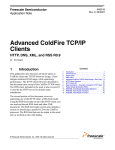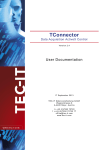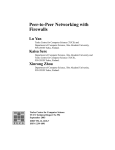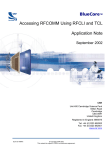Download MITATE User Manual
Transcript
MITATE : Mobile Internet Testbed for Application Traffic Experimentation [email protected] http://mitate.cs.montana.edu User Manual v 1.0 1 Content 1. MITATE Overview 2. Configuring MITATE Experiments 2.1 2.2 2.3 2.4 Traffic Definitions Defining a Transfer Defining an Explicit Content Defining a Criteria 3. MITATE Command Line API 3.1 3.2 3.3 3.4 3.5 3.6 3.7 3.8 3.9 3.10 3.11 Help Login and Logout Download Script to Initialize Local MySQL Instance Validate XML Configuration File Get Experiment Cost Check User’s Available Credits Upload an Experiment as XML Make Experiment Public Get Experiment Status Query Experiment Data Delete an Uploaded Experiment 4. Appendix 4.1 Configuring a MITATE Experiment to Send an HTTP GET Packet on Port 80 of a Web Server 4.2 Configuring a MITATE Experiment to Perform DNS Lookup and Get a Response Back 2 4.3 Configuring a MITATE Experiment to Send Packets of Different Message Sizes 4.4 Configuring a MITATE Experiment to Send Packets with Transmission Rates (Transmission Intervals) 4.5 Database Schema 3 1. MITATE Overview The technical problem we address is a lack of a programmable testbed for mobile application prototyping in production cellular networks. We have identified two challenges to building such a testbed. First, the personal nature of mobile devices creates user concerns over privacy, accountability for actions of foreign code being prototyped, and abuse of limited data plan and battery resources. Striking a balance between a flexible application prototyping environment and the safe execution of foreign code has been a difficult problem even in the more permissive wired environment. Second, because mobile battery and data plan resources are limited, testbed participants need adequate incentives to share them. Difficulty in enlisting mobile users has limited measurement studies to small samples, high cost of testbeds based on dedicated hardware, and collection of only high level network performance metrics. MITATE is a Mobile Internet Testbed for Application Traffic Experimentation made possible by novel solutions to the problems of security and mobile resource sharing. MITATE is unique in that it allows programmable application traffic experiments between mobile hosts and backend server infrastructure. MITATE provides strong client security by separating application code execution from traffic generation. MITATE also provides incentives and protections for mobile resource sharing through tit-for-tat mechanisms. MITATE's specialized traffic experiments can help developers answer questions crucial to mobile application design such as: What is the largest game state update message that can be reliably delivered under 100 ms?," Does my application traffic need to contend with traffic shaping mechanisms?," or Which CDN provides fastest downloads through a particular mobile service provider's network peering points?" 4 2. Configuring MITATE Experiments This section will elaborate the steps required in creating traffic definitions. These traffic definitions will serve as an input to the MITATE system. In order to submit these definitions to the MITATE backend servers and to start the experiments from your mobile device, you will be required to form a well defined XML file. This section contains explanations for defining an experiment which consists of transaction, transfer, content and criteria definitions. Below are a few examples which could help to get started immediately, if you are new to MITATE. These examples contains traffic definitions for executing experiments such as sending a well formed HTTP GET, DNS lookup request. 5 2.1 Traffic Definitions <transaction count=“10”> <criteria> <criteriaid>criteria1</criteriaid> </criteria> <transfers> <transfer repeat="1" delay="10"> <transferid>transfer1</transferid> </transfer> <transfer repeat="2" delay="20"> <transferid>transfer2</transferid> </transfer> <transfer repeat="1" delay="10"> <transferid>transfer1</transferid> </transfer> </transfers> </transaction> where: transaction : count* : repeat delay* : : To define a transaction within an experiment. Attribute of transaction, refers to number of different clients on which this transaction is executed. Attribute of transferid, refer to number of times transfer repeated. Attribute of transferid, refers to delay after which this transfer is executed. * refers to an optional field 6 2.2 Defining a Transfer <transfer> <id>transfer1</id> <sourceip>client</sourceip> <destinationip>1.2.3.4</destinationip> <type>2</type> <portnumber>5060</portnumber> <response>0</response> <packetdelay>0</packetdelay> <bytes> <explicit>1</explicit> <contentid>content1</contentid> <noofbytes></noofbytes> </bytes> <noofpackets>1</noofpackets> </transfer> where: id sourceip : : destinationip : type : portnumber : response : packetdelay : bytes : explicit : Unique identifier for a transfer within an experiment. Source ip address of the flow. (If source is device then ‘client’ else a server ip address like xxx.xxx.xxx.xxx) Destination ip address of the flow. (If destination is device then ‘client’ else a server ip address like xxx.xxx.xxx.xxx) Type of transport protocol. (‘1’ for UDP or ‘2’ for TCP) Port number at source and destination. Response if any expected from destination. (0 - No Response, 1 - Response expected) Expected delay in milliseconds between two successive packets. Data that needs to be transferred as described in contentid or noofbytes tag. Content if explicitly defined or use default content. 7 contentid : noofbytes : noofpackets : (0 - Use default content, 1 - Use explicit content) Id of the explicit content that needs to transferred. Number of bytes of random content to be transferred. Number of packets to be sent. Note: Size of a packet = noofbytes/noofpackets 8 2.3 Defining Explicit Content <content> <contentid>content1</contentid> <protocol>Skype</protocol> <data> <![CDATA[0x0100be07de55...]]> </data> <contenttype>HEX</contenttype> </content> where: content contentid protocol data contenttype : : : : : To define an explicit content. Unique identifier for the defined explicit content. Name of the content, as a user label only Actual content either in ASCII, HEX. Type of the content defined. (ASCII or HEX) 9 2.4 Defining a Criteria <criteria> <id>criteria1</id> <latitude>45.66962856799364</latitude> <longitude>-111.06049848720431</longitude> <radius>5000</radius> <networktype>cellular</networktype> <starttime>143001</starttime> <endtime>205959</endtime> <deviceid>client</deviceid> <minimumbatterypower>0</minimumbatterypower> <minimumsignalstrength>-1000</minimumsignalstrength> <networkcarrier>Verizon Wireless</networkcarrier> <devicemodelname>Galaxy Nexus</devicemodelname> </criteria> where: criteria id latitude longitude radius networktype starttime* endtime* deviceid* : : : : : : : : : To define criteria when transaction need to be executed. Unique id for the defined criteria within an experiment. Latitude of the reference location. Longitude of the reference location. Maximum distance (in Km) from the reference location. Type of the network (Wi-Fi or Cellular). Time after which transfer can be started. (HH24MMSS) Time before which transfer can be started. (HH24MMSS) Unique identifier of the device on which transaction is executed. (client for any device matching criteria or a device id) minimumbatterypower* : Minimum battery power required on the device. minimumsignalstregnth* : Minimum signal strength required on the device. networkcarrier* : Cellular Service Provider. devicemodelname* : Device model name. * refers to an optional field 10 3. MITATE Command Line API This section will elaborate various functionalities of the command line API required to interact with MITATE’s database servers. This API will help you uploading, deleting, querying data for experiments from the database server. With respect to cellular and Wi-Fi credit, this API will help you retrieve the cost of experiments, your available credit. An overview of the basic API functionality is as follows: login init validate getExpCost checkAvailableCredits upload makePublic getExpStatus query delete logout Logs in the user Setup local MySQL instance Validate configuration file Get experiment cost Check available credit Uploads an XML file Make the experiment public Get current experiment status Retrieve data for an executed experiment Deletes the experiment with specified ID Logs out the user 11 3.1 Help To see the list of supported options. ./mitate.sh help Lists the set of supported options, each option is detailed in sections 3.2 to 3.10. 12 3.2 Login and Logout to the API If you are a first time user, please create your login credentials at http://mitate.cs.montana.edu/mitate_signup.php. You will be asked for these credentials when interacting with MITATE’s command line API (mitate.sh). To login into MITATE use the following command: ./mitate.sh login Following a successful login, mitate.shwill save an authentication key for subsequent commands until you log out. You can remove that key by calling ./mitate.sh logout A failed login will generate an error message. 13 3.3 Download Script to Initialize Local MySQL Instance Since the output of any experiment is returned to the user in form of SQL Insert Statements, this initialization command is required to set up all the tables in the user’s local MySQL instance for MITATE data. The following command will generate script required to setup the local database: ./mitate.sh init <output_file> This command requires two command line parameters: initialization operation and output filename. After the above command is issued, the scripts required to set up a local MySQL instance with MITATE data will be stored in output_file. The SQL commands saved in output_filecan then executed using MySQL Query Engine, or any other SQL-compatible database front end. For example, for a database schema m_schemaand user m_user, and output file of the init command localdb.sql, a user can create a local instance of MITATE database using: mysql -u m_user -p m_schema < localdb.sql 14 3.4 Validate XML Configuration File This command allows users to compare their Configuration file in the form of XML against the MITATE XML Schema Definition file as required before uploading experiments. Although the uploadcommand will validate the input XML file before uploading the experiment, the validatecommand will help users to validate their XML file without actually issuing an upload experiment request. The following is the syntax to validate an XML file: ./mitate.sh validate <XML_Filename> The return of the command is either a confirmation of the experiment being validated, or an error describing how the experiment XML does not comply with the MITATE experiment definition schema. 15 3.5 Get Experiment Cost This command allows users to check the total amount of Cellular data credit and Wi-Fi data credit required by an experiment. ./mitate.sh getExpCost <XML_Filename> The result of this command will be the total cellular and Wi-Fi data credits that the given XML file will require the user to have available in his account if this experiment were to be executed. 16 3.6 Check User’s Available Credits This command allows users to check their available cellular and Wi-Fi data credit. The following command is required to be executed to check the available credits: ./mitate.sh checkAvailableCredits The command will return the available cellular and WiFi data credit as well as the amount of credit earned. 17 3.7 Upload an Experiment as XML To upload an experiment users need to execute the uploadcommand. ./mitate.sh upload <XML_Filename> This command requires a valid XML experiment configuration file. There can be three outcomes of this query which are as follows: 1. XML Validation Error - Before uploading any experiment, the API first validates the input XML file against MITATE’s XML Schema Definition File which can be found at http://mitate.cs.montana.edu/sample/Mitate_Sample_Configuration_File_XML_Form at.xsd. 2. Insufficient Available Measurement Credit - If the total volume of data in an experiment, that needs to be exchanged between mobile devices and MITATE backend servers, exceed the available credit balance of the user, the API will generate an error message asking the user to either reduce the number of transfers from the XML file or increase the mobile and Wi-Fi credit for his account. 3. Experiment Uploaded Successfully - If none of the above three cases are true, the API will process and upload the XML file and finally output the success message with a unique experiment ID . 18 3.8 Make Experiment Public Since by default, all the experiments can be accessed by the user who uploaded them, this command will enable the owner of the experiment to set its permissions as public (with a confirmation) in which case its execution as well as the data associated with it can then be accessed by anyone. In general, an experiment whose permissions are set as “private” would allow the owner of the experiment to execute, delete and fetch any data associated with it. An experiment whose permissions are set as “public” would allow all the users to execute and fetch the data associated with it. To delete a public experiment, the user who uploaded the experiment needs to issue a delete experiment request as described above and cannot be deleted by any other user. The following command needs to be executed to update the permissions of an experiment: ./mitate.sh makePublic <experiment_ID> This command requires two command line parameters, an update operation and experiment ID. After this command is issued, the API will check if the user is the owner of the experiment and will ask for a final confirmation to set the experiment as public. Once the experiment is set public, it can be made private. 19 3.9 Get Experiment Status To get the current status of an uploaded experiment, consisting of the total transfers in the XML configuration file, the user is required to run the following command: ./mitate.sh getExpStatus <experiment_ID> There are two possible outcomes of executing this command: 1) Success: In this case, the command will return the total number of transfer in the experiment and the total number of transfers that have been executed. 2) Permission denied: If in case user queries the current status for an experiment that is either not uploaded by the user or does not exist, the user will get a permission denied error. 20 3.10 Query Experiment Data In order to retrieve all the data associated with a completed experiment, the user is required to issue the following command: ./mitate.sh query user_experiment_list.txt <output_filename> This command requires two command line parameters an input file containing list of experiment IDs and an output file for SQL statements that contain experiment data. The experiment IDs of all experiments that were uploaded successfully are stored in “user_experiment_list.txt” file where each experiment ID is stored in one separate line. To query for data for a particular experiment only, a user can pass in a file that contains only one experiment ID. When a user issues a request to query data associated with all the experiments in the “user_experiment_list.txt”, the API can generate two following outcomes: 1. Error in Retrieving Data - The API throws an error if it finds an experiment ID, in the user_exeriment_list.txt file, that is not owned by the user requesting its data or the user does not have permissions to access its data or the experiment no longer exists in the database. 2. Data Retrieved Successfully - For all those experiments for which there were no errors, the data is appended in the output file in form of SQL Insert Statements that can be used to insert data into user’s local MySQL instance. 21 3.11 Delete an Uploaded Experiment To delete an uploaded experiment you will need to execute the following command from your terminal. ./mitate.sh delete <experiment_ID> This command requires two command line parameters, delete operation and experiment ID. Once the above command is executed, the user will asked to give a confirmation to issue a delete experiment request. If the user responded with “y” (as in yes), there can be two outcomes of issuing the command which are as follows: 1. Invalid Experiment ID - The API will throw an invalid experiment ID error if either the experiment ID does not belong to the user requesting its deletion or has already been deleted before by the user who uploaded that experiment. 2. Experiment Deleted Successfully - If the user requesting the deletion of an experiment ID is the owner of that experiment and the experiment still exists, the API will delete the experiment and all the data collected associated with that experiment. 22 4. Appendix 4.1 Configuring a MITATE Experiment to Send an HTTP GET Packet on Port 80 of a Web Server <?xml version="1.0" encoding="ISO-8859-1"?> <entry> <defines> <transferdefine> <transfers> <transfer> <id>transfer1</id> <sourceip>client</sourceip> <destinationip>mitate.cs.montana.edu</destinationip> <packetdelay>0</packetdelay> <type>TCP</type> <portnumber>80</portnumber> <response>0</response> <bytes> <explicit>1</explicit> <contentid>content1</contentid> </bytes> <noofpackets>1</noofpackets> </transfer> </transfers> </transferdefine> <contentdefine> <content> <contentid>content1</contentid> 23 <protocol>HTTP</protocol> <data> <![CDATA[GET /images/cdn.jpg HTTP/1.1\r\nHost: mitate.cs.montana.edu\r\nUser-Agent: Mozilla/5.0 (Windows NT 6.1; WOW64; rv:20.0) Gecko/20100101 Firefox/20.0\r\nAccept: text/html,application/xhtml+xml,application/xml;q=0.9,*/*;q=0.8\ r\nAccept-Language: en-us,en;q=0.5\r\nAccept-Encoding: gzip,deflate\r\nConnection: keep-alive\r\n]]> </data> <contenttype>ASCII</contenttype> </content> </contentdefine> <criteriadefine> <criteria> <id>criteria1</id> <latitude>45.66962856799364</latitude> <longitude>-111.06049848720431</longitude> <radius>50000</radius> <networktype>cellular</networktype> </criteria> </criteriadefine> </defines> <transactions> <transaction count="1"> <transfers> <transfer repeat="1" delay="0"> <transferid>transfer1</transferid> </transfer> </transfers> 24 <criteria> <criteriaid>criteria1</criteriaid> </criteria> </transaction> </transactions> </entry> 25 4.2 Configuring a MITATE Experiment to Perform DNS Lookup and get a Response Back For configuring a MITATE experiment as a DNS lookup, the XML file containing traffic definitions should look similar to <?xml version="1.0" encoding="ISO-8859-1"?> <entry> <defines> <transferdefine> <transfers> <transfer> <id>transfer1</id> <sourceip>client</sourceip> <destinationip>8.8.8.8</destinationip> <packetdelay>0</packetdelay> <type>UDP</type> <portnumber>53</portnumber> <response>1</response> <bytes> <explicit>1</explicit> <contentid>content1</contentid> </bytes> <noofpackets>1</noofpackets> </transfer> </transfers> </transferdefine> <contentdefine> <content> <contentid>content1</contentid> <protocol>DNSLookup</protocol> 26 <data> <![CDATA[1b3f0100000100000000000006736561726368096a6170616 e706f7374026a700000010001]]> </data> <contenttype>HEX</contenttype> </content> </contentdefine> <criteriadefine> <criteria> <id>criteria1</id> <latitude>45.66962856799364</latitude> <longitude>-111.06049848720431</longitude> <radius>50000</radius> <networktype>cellular</networktype> </criteria> </criteriadefine> </defines> <transactions> <transaction count="1"> <transfers> <transfer repeat="1" delay="0"> <transferid>transfer1</transferid> </transfer> </transfers> <criteria> <criteriaid>criteria1</criteriaid> </criteria> </transaction> </transactions> 27 </entry> 28 4.3 Configuring a MITATE Experiment to Send Packets of Different Message Size <?xml version="1.0" encoding="ISO-8859-1"?> <entry> <defines> <transferdefine> <transfers> <transfer> <id>transfer1</id> <sourceip>client</sourceip> <destinationip>1.2.3.4</destinationip> <packetdelay>0</packetdelay> <type>UDP</type> <portnumber>1234</portnumber> <response>0</response> <bytes> <explicit>0</explicit> <noofbytes>256</noofbytes> </bytes> <noofpackets>1</noofpackets> </transfer> <transfer> <id>transfer2</id> <sourceip>client</sourceip> <destinationip>1.2.3.4</destinationip> <packetdelay>0</packetdelay> <type>UDP</type> <portnumber>1234</portnumber> <response>0</response> 29 <bytes> <explicit>0</explicit> <noofbytes>512</noofbytes> </bytes> <noofpackets>1</noofpackets> </transfer> </transfers> </transferdefine> <criteriadefine> <criteria> <id>criteria1</id> <latitude>45.66962856799364</latitude> <longitude>-111.06049848720431</longitude> <radius>50000</radius> <networktype>cellular</networktype> </criteria> </criteriadefine> </defines> <transactions> <transaction count="1"> <transfers> <transfer repeat="1" delay="0"> <transferid>transfer1</transferid> </transfer> <transfer repeat="1" delay="0"> <transferid>transfer2</transferid> </transfer> </transfers> <criteria> 30 <criteriaid>criteria1</criteriaid> </criteria> </transaction> </transactions> </entry> 31 4.4 Configuring a MITATE Experiment to Send Packets with Transmission Rates (Transmission Intervals) <?xml version="1.0" encoding="ISO-8859-1"?> <entry> <defines> <transferdefine> <transfers> <transfer> <id>transfer1</id> <sourceip>client</sourceip> <destinationip>1.2.3.4</destinationip> <packetdelay>100</packetdelay> <type>UDP</type> <portnumber>1234</portnumber> <response>0</response> <bytes> <explicit>0</explicit> <noofbytes>256</noofbytes> </bytes> <noofpackets>1</noofpackets> </transfer> <transfer> <id>transfer2</id> <sourceip>client</sourceip> <destinationip>1.2.3.4</destinationip> <packetdelay>200</packetdelay> <type>UDP</type> <portnumber>1234</portnumber> <response>0</response> 32 <bytes> <explicit>0</explicit> <noofbytes>512</noofbytes> </bytes> <noofpackets>1</noofpackets> </transfer> </transfers> </transferdefine> <criteriadefine> <criteria> <id>criteria1</id> <latitude>45.66962856799364</latitude> <longitude>-111.06049848720431</longitude> <radius>50000</radius> <networktype>cellular</networktype> </criteria> </criteriadefine> </defines> <transactions> <transaction count="1"> <transfers> <transfer repeat="1" delay="0"> <transferid>transfer1</transferid> </transfer> <transfer repeat="1" delay="0"> <transferid>transfer2</transferid> </transfer> </transfers> <criteria> 33 <criteriaid>criteria1</criteriaid> </criteria> </transaction> </transactions> </entry> 34 4.5 Database Schema This section describes the MITATE database schema that is provided to users to query and analyse the data stored in their local MySQL instance. Figure 1. MITATE Database ER Diagram 35 Experiment tables experiment contains experiment related information like id, user who uploaded the experiment, permissions on the experiment which is either public or private and cellular data / wifi data used by the experiment. transactions contains transactions related information like transactionid, user who uploaded the transaction and the number of times transaction to be executed and is actually executed. transfer contains transfer related information like transferid, transfer specifications like sourceip/destinationip, portnumber, number of bytes of data to be transferred, packetdelay between successive packets, content if explicit content to be sent and the number of packets. criteria contains criteria related information like criteriaid, specification of criteria containing the start time, endtime, network type, battery power, signal strength and the device that can execute the transfer. Link tables (Miscellaneous) trans_criteria_ links the transactions and criteria tables. link trans_transfer _link links the transactions and transfer table and also it depicts the order in which transfers are executed in a particular transaction. Metric tables metric metricdata contains all the metric names, there are currently 23 different metrics collected. contains the values corresponding to each metric for a particular transfer executed by a device. transfermetrics contains the latencies and throughput's per packet as base64 encoded string for udp and tcp. packetmetrics contains the latencies and throughputs calculated for each packet in a particulaar transfer. 36 Device tables userdevice contains the device related information like device model name and the network carrier used by the device. Log tables logs contains the errors that are generated while executing transfers on a particular device. 37












































